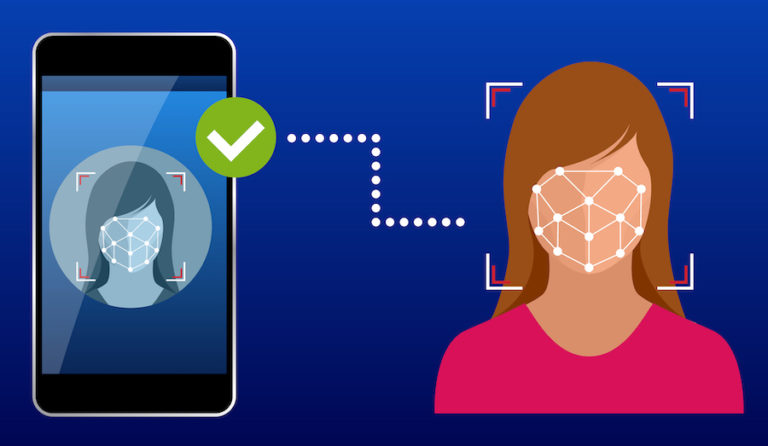When people think of biometric facial technology, they typically think about unlocking their phones by scanning their face.
It’s actually Biometric Facial Comparison (BCF) or facial authentication that is used to verify your identity to unlock your phone, gain security access to a building, or even at the airport gate.
Facial recognition, on the other hand, is used to identify a person in crowds, on the streets, or in pictures to confirm a person’s identity, and it’s often used as surveillance technology.
Biometric Comparison Technology Has Been Around for Over a Century
According to Oxford Languages biometric means involving the automated recognition of individuals by means of unique physical characteristics, typically for the purposes of security.
Interestingly, the word came to be used as early as 1902 for the application of statistics and mathematics to the study of biology. Its use exploded around the year 2000.

The well-read novelist Sir Arthur Conan Doyle depicted his fictional character Sherlock Holmes using biometric methods years before they were adopted by official police forces in both Britain and America. According to the Encyclopedia Britannica, the first case in which fingerprints are ever mentioned is in his book The Sign of the Four (1890).
Today’s law enforcement and state and federal agencies regularly use different kinds of biometric data for identification purposes. These include fingerprints, facial features, iris patterns, voice samples, and DNA.
The Evolution from Fingerprints to Biometric Facial Comparison
In the early 1970s police departments began to use the Automated Fingerprint Identification System (AFIS) to automate their otherwise manual fingerprint identification process, making it faster and more effective.
Before that a trained human examiner was required to compare a fingerprint image to the prints on file manually. If there was a match, the examiner would double-check the two prints to ensure that they were identical. This could take many hours if not days. Now they can match a fingerprint against a database of millions of prints in seconds.
That same speed and accuracy is now available in facial comparison technology.
Biometric Facial Comparison Technology Now Used at U.S. Airports
According to U.S. Customs and Border Protection (CPB), “The biometric facial comparison process occurs only at a time and place where travelers are already required by law to verify their identity by presenting a travel document.”
The new photo of the traveler is compared to the photo previously collected. The facial comparison process only takes a few seconds and is over 97% accurate.
According to a CBP report, the agency has processed more than 200 million travelers using biometric facial comparison technology and prevented more than 1,600 impostors’ entry into the U.S.
Digital Forensics Integration: The Key to Biometric Facial Comparison Technology
Digital forensics is often used to identify and investigate both cybersecurity and physical security incidents. With the rapid advancement of smartphone technology and the widespread use of closed-circuit television cameras, digital forensics is constantly evolving to improve evidence acquisition, processing, analysis, and storage capabilities.
As with many new technologies, the more a technological term is used, the more an incorrect definition or a misunderstanding of it can quickly spread.
Fortunately, the Biometrics Institute has put together a list of top 10 takeaways from the National Institute of Standards and Technology (NIST) Face Recognition Vendor Test (FRVT) Part 3: Demographic Effects Report, published in December 2019.

Advanced Technologies for Community Corrections
Judges, probation, and pretrial agencies can also leverage biometric facial comparison technology in solutions that help individuals stay accountable as they await trial or meet the conditions of their release. BI Incorporated is a leader in community corrections solutions tailored to help manage individual risk, increase court appearances, and promote individual engagement and community stabilization.
Several devices in the BI electronic monitoring solutions continuum use biometric facial comparison technology. You can also learn more about our approach to biometric facial technology in our 2021 post “Understanding Biometric Facial Software & Technology.”
The Least Restrictive Form of Supervision: Mobile App Monitoring
BI SmartLINK® provides a secure platform for real-time communication between officers and clients. It is a practical and affordable app that enables agencies to securely monitor, collect data, automate administrative work, and enhance compliance and accountability using biometric facial comparison check-in technology.
Three top advantages of BI SmartLINK are:
- Offers tiered program options—select based on client risk and needs
- Reduces time spent on administrative work as clients submit information and schedules electronically
- Simplifies communication between clients and officers through secure messaging and video, calendar and resource access, and push notifications
Other community supervision solutions that feature biometric facial comparison are BI SL3®, BI VeriWatch™, and BI Mobile®.




